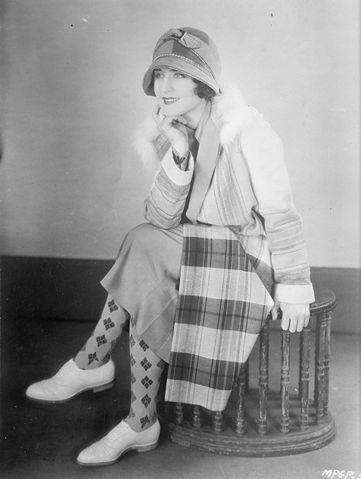-
Silent Star of March 1996
Norma Shearer
 Edith Norma Shearer was born August 11,
1902 in Montreal, Canada. The daughter of Andrew and Edith Shearer,
Norma's childhood would be remembered by her years later as a "pleasant
dream," filled with piano, skating, skiing, and swimming. But by the
time she was 9 years old, little Norma Shearer knew exactly what she
wanted from life: inspired by a performance by the Dolly Sisters, Norma
knew she would be an actress.
Edith Norma Shearer was born August 11,
1902 in Montreal, Canada. The daughter of Andrew and Edith Shearer,
Norma's childhood would be remembered by her years later as a "pleasant
dream," filled with piano, skating, skiing, and swimming. But by the
time she was 9 years old, little Norma Shearer knew exactly what she
wanted from life: inspired by a performance by the Dolly Sisters, Norma
knew she would be an actress.Star-struck Edith Shearer, convinced that Norma was destined to be famous, was determined to see it happen. Even as the family fortunes were fading, Edith packed up Norma and her sister Athole and headed for New York. Armed only with a letter of introduction to Florenz Ziegfeld, the great showman, Norma finally met with him only to be told she was too short, had fat legs, and a cast in one eye.
Norma, Edith and Athole eventually made their way to the fledgling motion pictures business when money began to run low. Norma gained work as a bit player in small films, and was fortunate enough to work as an extra on D.W. Griffith´s Way Down East (1920). Soon after she gained the attention of agent Edward Small, and thanks to his efforts Norma Shearer the actress was launched into films. Her first feature role -- fourth billing -- was in The Stealers (1920), a film produced by Christy Cabanne, later to become King of the B films.
This inauspicious debut was followed by a bit part in a Norma Talmadge film, which ended up on the cutting room floor. However, after her third film, Torchy´s Millions (1920), roles were scarce, forcing the Shearers back to Montreal.
The trip back was not a total loss, however -- only a few weeks after her return, Norma was asked to do some modeling, resulting in letters of introduction should she return to New York. A telegram from Small offering Norma a role another film made a return necessary, and Edith and Norma once again headed for New York.
It was just as well that Norma did not accept the role in Pink Tights (1920) for after passing on an offer from Universal, who wouldn't pay for Edith's train fare to accompany Norma to Los Angeles, Norma received a more lucrative offer from the Mayer Company. By now, she had the benefit of 6 more roles under her belt, good notices in the trades, and a small following. Norma Shearer was on her way.
By the time Norma made it to California, the Mayer Company had merged with Metro Studios and the Goldwyn Company to become Metro-Goldwyn-Mayer, or MGM. Destined to become one of the greatest studios in the history of Hollywood, MGM's rise was credited to its vice-President "boy wonder," for by now Irving Thalberg had gained a reputation as a genius for turning out quality films. Under Thalberg's tutelage, Norma made a number of "small" films such as The Devil´s Circus (1926), The Waning Sex (1926), and His Secretary (1925). None of these films were given MGM's big-budget, star treatment, but they did help to bolster Norma's image, build her fan base, and help her polish her acting.
Norma's chance at stardom finally came with the role of Kathy in Romberg's The Student Prince in Old Heidelberg (1927). Not only did this prove Norma's abilities in the eyes of the studio, but in the eyes of Thalberg, as well. After filming was completed, Thalberg and Norma became engaged.
While their union was brief, for Thalberg's delicate health ensured he would not live to see 50, it was for Norma the height of her career, as well as what would become a point of reference for her at the end of her life. Not that Norma's "marrying the boss" gave her an advantage professionally; her countless "B" films for the studio were proof that the roles she won were a result of paying her dues. She began making the "prestige" films for MGM that she had been working so hard for, heading films as The Divorcee (1930), and her final silent, A Lady of Chance (1928).
One of the few silent stars to make the transition to the talkies with ease, Norma's first talking role was the title character in The Trial of Mary Dugan (1929). Thalberg built the suspense by leaving Norma's character speechless until almost the end of the film. The picture was a success, and Norma's career was secure, with her career reaching its pinnacle with the big-budget, prestige film Marie Antoinette (1938).
After Thalberg's death, Norma continued to act, but left films for good after Her Cardboard Lover (1942) in 1942. She later married Marti Arrouge, a ski instructor, and lived out the rest of her days traveling, skiing, and maintaining the ties to MGM and the golden days of the silver screen. She died at the Motion Country Picture Home June 12, 1983.
Glen Pringle / pringle@yoyo.its.monash.edu.au
Kally Mavromatis / only1kcm@yahoo.com Copyright © 1996-2012 by Glen Pringle and Kally Mavromatis
ISSN 1329-4431